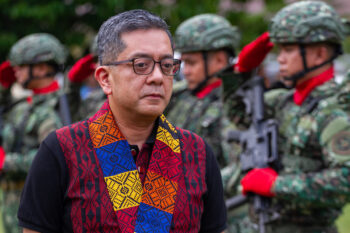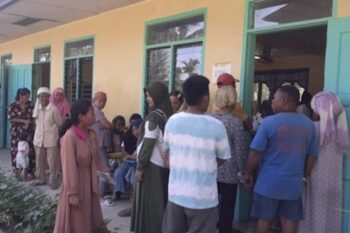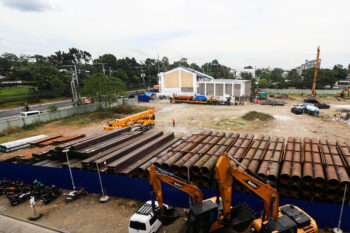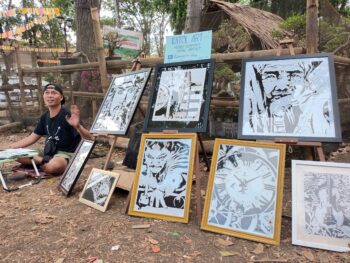
Various Authors
Edited by Carolyn O. Arguillas
Published by the Mindanao Institute of Journalism, Davao City, 2021
DAVAO CITY (MindaNews / 23 August) — The Austrian-born American journalist and diplomat who served as Managing editor of TIME magazine, Henry Anatole Grunwald (1922-2005) once wrote: “Journalism can never be silent: that is its greatest virtue and its greatest fault. It must speak, and speak immediately, while the echoes of wonder, the claims of triumph and the signs of horror are still in the air.”
The five months that convulsed Marawi City that wreaked havoc to what was once a bustling city which began on May 23, 2017 happened four years ago. But for the Meranaws who remain displaced from this city by the lake, “the signs of horror are still in the air.” The sad fact is that the promises of the Duterte administration for a speedy recovery and rehabilitation of the city so its inhabitants can claim back their homes and to bring the city back to its feet remain unfulfilled.
The images appearing on screens – from the TV screens in our living rooms to those of our computers and cell phones – as the siege of Marawi was taking place in real time showed a great confusion and disorder as rebels took control of the city, bombs were being dropped and civilians scampered everywhere to dodge the bullets. Tragic images of the city’s devastation then followed the actual siege.
But pray tell, what was the quality of the reportage from mainstream mass media (both print and broadcast) as well as from social media? Filipinos as well as non-Filipinos interested in knowing the what, why and how of the battle of Marawi searched far and wide to find out what really happened and what led to the siege.
The imposition of martial law throughout Mindanao following the siege complicated the entire scenario that needed to be reported accurately. Fake news in social media and censored articles in mass media further muddled the attempts of committed journalists to ferret out the truth behind the evolving events. Restrictions on media coverage in the actual locations of the siege was strictly imposed by the military further frustrating speedy and accurate news coverages.
Thus so many questions were left unanswered and to this day these are still lingering questions: Why was there a failure on the part of the State military apparatus’ intelligence to predict the attack of the ISIS-affiliated rebels? Why it took all of five months to defeat what was supposedly a rag-tag group of rebels? In what way was the U.S. involved in this battle given some reports of American engagement? How many civilians actually lost their lives in the course of the battle of Marawi? What was the total cost of this war and who shouldered the costs? Why is it taking forever to allow the residents to reclaim their homes and properties?
So how was the reporting of this incident which is now labeled one involving “violent extremism?” In an attempt to provide details on what happened in the aftermath of the siege, a number of authors have published their respective narratives, namely Criselda Yabes (The Battle of Marawi), Carmela Founbuena (Marawi Siege: Stories from the Frontlines) and Phil Fortuno (No Man Left Behind). An article appearing in Conflict, South and Southeast Asia website written by Robert Postings posted on December 24, 2017 gave a brief summary of the battle.
Now comes Mindanao Institute of Journalism’s Reporting Violent Extremism: Lessons from Mindanao written by a group of Mindanawon writers and edited by Carolyn O. Arguilas. In her Preface of the 170-page book, Ms. Arguillas wrote: “MindaNews sent out invitations to reporters who covered the Marawi Siege… for a roundtable discussion.. on Reporting Marawi, Reporting ‘Violent Extremism.’ The …Siege… stands out not only because it is the longest and most intense armed conflict in an urban setting in the country but also because it has become, internationally, an example of ‘violent extremism’”.
Following the roundtable discussion and listening to “the voices of the Meranaws displaced by the war, ourselves and resource persons from civil society,” the group planned to published an anthology. This book was meant “to accompany…(the reader) to a journey of understanding the context of stories like Marawi, of looking back to history and connecting the dots to the present, of seeking ways to address the problem other than the usual military solution.”
Fifteen authors contributed to this anthology, including a Cardinal of the Roman Catholic church, a member of Parliament of the Bangsamoro Autonomous Region in Muslim Mindanao, a humanitarian worker who was kidnapped by the Abu Sayyaf in Basilan, university professors, civil society individuals and MindaNews staff writers. Eight of the writers are women, seven are men. Seven are Muslims; most being Meranaws .
The articles include essays, speeches and talks given at fora and conferences, and an article by a blogger. The essays range from historical (Canuday’s Vagaries, Politics, and Evolution of Violent Extremism in Mindanao) to sociological (Limba’s Is ‘Terror’ Marawi’s single story?) and theological (Quevedo’s Open Conflicts, Building Bridges of Peace), from a reflection paper based on an actual harrowing experience (Mendoza’s Reflections of an Abu Sayyaf Kidnap Victim – Moving Forward) to a feminist discourse (Gutoc’s Mothers Were Heroes).
Most of the articles are short and easy to read. There are many parts that are moving. In one of the essays the reader encounters this lamentation following their evacuation: “Where can our children get their Islamic and Arabic education? Are there Madrasah schools in Christian places? What will happen to our senses? How can it remain Islamized when what is mostly eaten, seen, touched, felt and hear in non-Muslim places are un-Islamic? Our religious beliefs are at stake.” (Lao Bula, p. 141).
However, there are also voices of longing mixed with a sense of hope: “When the gunshots have dissipated and the land no longer shakes with the explosions, we will go home to our ingud a pilombayan (land of our childhood). We will love it more, more than we loved it before. We will heal its wounds, each bullet hole on the walls. We will scrub our streets off the blood that stained it. We will paint the burnt walls with vibrant colors of hope.” (Dicali, p. 117).
Many of these articles are not just reporting the news. They reveal what were triggered in the minds and hearts of the writers and how they tried to speak their voice as eloquently as possible. In so doing, they constitute written words that can be considered of superior or lasting artistic merit which is how literature is oftentimes defined. For after all, in the words of Matthew Arnold, the English poet and cultural critic – “journalism is literature in a hurry.”
With this book, the Mindanao Institute of Journalism seeks to fulfill its vision of being the leading provider of accurate, timely and comprehensive news and information on Mindanao and its peoples, serving economically, politically and culturally empowered communities. In a country where once a free press reigned supreme across Asia and now merely a pale shadow of what it used to be, this Institute and its flagship – the Mindanews – strives to be true to what journalism is all about, namely that it is a country’s fourth estate playing a crucial role in maintaining democracy. But it can only be so, for as long as it is a force for progressive social change.
Since it was established two decades ago, MindaNews – through the daring efforts of its staff and network of correspondents across southern Philippines – has been the only alternative source of news reporting on various events unfolding in this part of the country. While operating mainly online, it has reached not only the four corners of the archipelago but to other parts of the globe where there are people interested in finding out breaking news from this part of the world.
One can only hope that there is enough patronage of this kind of reporting among Mindanawons and all people of goodwill who share the dream of a Mindanao that can finally be freed of all forms of violence and extremism.
[MindaViews is the opinion section of MindaNews. Redemptorist Brother Karl Gaspar is a professor at St. Alphonsus Theological and Mission Institute (SATMI) in Davao City and until recently, a professor of Anthropology at the Ateneo de Davao University. Gaspar is author of several books, including “Manobo Dreams in Arakan: A People’s Struggle to Keep Their Homeland,” which won the National Book Award for social science category in 2012, “Desperately Seeking God’s Saving Action: Yolanda Survivors’ Hope Beyond Heartbreaking Lamentations,” two books on Davao history, and “Ordinary Lives, Lived Extraordinarily – Mindanawon Profiles” launched in February 2019. He writes two columns for MindaNews, one in English (A Sojourner’s Views) and the other in Binisaya (Panaw-Lantaw). Gaspar is a Datu Bago 2018 awardee, the highest honor the Davao City government bestows on its constituents.]







